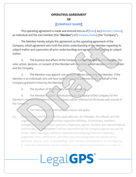Why Your Service Contracts Keep Going Wrong (The MSA Problem)
If you're a business owner who's had a service project go sideways, you're not alone. Maybe your website redesign spiraled from $5,000 to $15,000....
10 min read
LegalGPS : Oct. 31, 2025
Retainer agreements should be your business's safety net, ensuring predictable income while protecting you from scope creep and payment delays. Yet industry research shows that 40% of service-based businesses experience significant problems with their retainer contracts within the first year.


Legal GPS Pro
Protect your business with our complete legal subscription service, designed by top startup attorneys.
The consequences aren't just financial. Failed retainers destroy client relationships, create legal vulnerabilities, and force entrepreneurs into reactive firefighting mode instead of strategic growth.
But here's the encouraging news: the businesses that get retainers right don't just avoid these pitfalls—they build sustainable competitive advantages. They enjoy predictable cash flow, stronger client boundaries, and the freedom to focus on delivering exceptional value rather than chasing payments.
Retainer agreements occupy a unique space in business contracts. Unlike one-time service agreements or simple purchase orders, retainers must balance ongoing relationships with specific deliverables, flexible scope with clear boundaries, and trust with legal protection.
This complexity creates multiple failure points that don't exist in simpler contracts. When a retainer fails, it typically cascades through several business areas simultaneously—cash flow, client relationships, team productivity, and legal exposure.
The stakes are particularly high for service-based entrepreneurs who often invest significant upfront time in client onboarding and relationship building. A failed retainer doesn't just mean lost revenue; it means lost opportunity cost and damaged reputation in what are often tight-knit professional communities.

Retainer Agreement
Use our Retainer Agreement Template to establish a solid, ongoing working relationship that clarifies deliverables, payment schedules, and mutual responsibilities.
Trusted by 1,000+ businesses to safeguard their LLCs.
Most entrepreneurs approach retainers with an optimistic bias, assuming good faith from all parties and smooth execution of services. This optimism, while admirable, often leads to incomplete planning for common scenarios like scope creep, communication breakdowns, or changing business priorities.
Clients, meanwhile, often misunderstand what they're purchasing with a retainer. They may view it as a down payment on unlimited services rather than a commitment to a specific scope of work. This fundamental misalignment creates tension from day one.
Sarah Chen built her digital marketing agency to $300,000 in annual revenue using project-based contracts. When she transitioned to retainers, she was excited about the promise of predictable income. Her first major retainer client, TechFlow Solutions, seemed perfect—a growing software company that needed ongoing marketing support.
Sarah's retainer agreement specified "comprehensive digital marketing services" for $8,000 monthly. Within three months, TechFlow was requesting daily strategy calls, complete website redesigns, and 24/7 campaign monitoring. When Sarah pushed back, TechFlow argued these were included in "comprehensive services."
The relationship deteriorated rapidly. TechFlow withheld payment claiming breach of contract, while Sarah struggled to quantify her actual deliverables. The dispute lasted eight months, cost $15,000 in legal fees, and ultimately resulted in Sarah refunding $24,000 in retainer payments.
The failure stemmed from vague scope definition, unclear communication protocols, and absence of change management procedures. Sarah's optimistic assumption that "comprehensive" would be interpreted reasonably proved costly.
Through analysis of hundreds of failed retainer agreements, five patterns emerge consistently. Understanding these flaws is essential because they often work together, creating compound problems that are difficult to resolve once they begin.
Scope creep kills more retainer agreements than any other single factor. It begins innocuously—a client asks for "just one small addition" to the agreed services. Without clear boundaries and change management processes, these small requests accumulate into major scope expansions.
The insidious nature of scope creep makes it particularly dangerous. Unlike sudden contract disputes, scope creep evolves gradually, making it difficult to identify the exact moment when the agreement becomes unsustainable.
Successful retainer management requires treating scope as a precious resource that must be actively protected. This means saying no to requests that fall outside defined parameters, even when those requests seem reasonable or simple.
Many entrepreneurs focus extensively on scope definition while giving insufficient attention to payment mechanics. Standard "Net 30" terms that work for project-based invoicing can create devastating cash flow problems in retainer relationships.
Consider the mathematics: if you're providing ongoing services under a retainer but waiting 30 days for payment, you're essentially providing interest-free loans to your clients. For businesses with multiple retainer clients, this can quickly create unsustainable cash flow gaps.
Structure retainer payments to arrive before you deliver the majority of each month's services. Net 15 terms with monthly invoicing on the first of each month ensures payment arrives by the 16th, when most of your work typically occurs in the latter half of the month. This simple shift can dramatically improve cash flow management.
Retainer relationships require ongoing communication, but most agreements fail to establish clear protocols for how this communication occurs. Without structure, communication becomes either overwhelming (constant interruptions) or insufficient (missed expectations).
The most successful retainer agreements specify not just what services will be provided, but how communication will be managed. This includes designated contact points, response time expectations, meeting schedules, and escalation procedures.
David Martinez learned about communication protocols the hard way. His first managed IT retainer client, Riverside Medical Group, generated 47 support tickets in the first week—many for issues that weren't actually technical problems.
After restructuring his retainer agreement, David implemented a three-tier communication system. Tier 1 handled routine requests through a ticketing system with 24-hour response guaranteed. Tier 2 covered urgent issues requiring four-hour response. Tier 3 provided emergency support with one-hour response for true system failures.
Each tier had different contact methods and clear definitions of what qualified. David also added monthly strategic consultations to address broader IT planning, preventing many issues from becoming urgent tickets.
The result: ticket volume dropped 60% while client satisfaction increased. David's clear communication structure helped clients understand what they were purchasing and how to access different levels of support appropriately.
Most retainer agreements focus on how the relationship will work when everything goes well, but fail to plan adequately for how it will end when things go poorly. Weak termination clauses create legal vulnerabilities and practical nightmares.
Effective termination planning requires addressing several scenarios: mutual termination, termination for cause, termination for convenience, and termination due to changed circumstances. Each scenario needs specific notice periods, final payment terms, and deliverable handover procedures.
Business needs evolve constantly, and retainer agreements must accommodate this reality while maintaining clear boundaries. Many agreements fail because they either resist all changes (creating client frustration) or allow unlimited changes (creating provider exhaustion).
The most successful retainers include formal change management procedures that make modifications possible but controlled. This typically involves quarterly review meetings, formal change request processes, and clear pricing for scope additions.
Creating retainer agreements that consistently succeed requires systematic attention to both legal protection and practical relationship management. The goal isn't to create an adversarial contract, but rather to establish clear expectations that enable both parties to succeed.
Effective scope definition follows the SCOPE framework: Specific deliverables, Clear timelines, Objective success metrics, Parameters for variations, and Exit criteria for each service component.
Specific deliverables must be quantifiable and observable. Instead of "social media management," specify "creation and scheduling of 20 original posts per month across Facebook, LinkedIn, and Instagram, plus response to comments within 24 hours during business days."
Clear timelines establish when deliverables will be completed and how workload is distributed throughout the retainer period. This prevents last-minute rush work and helps clients understand when to expect results.
Objective success metrics enable both parties to evaluate whether services are meeting expectations. These should be measurable and tied to business outcomes rather than activity levels.
Build explicit buffers into your retainer scope by defining 80% of the work clearly and reserving 20% for client-directed activities within agreed parameters. This provides flexibility while maintaining boundaries. For example, "16 hours of specified deliverables plus 4 hours of client-requested activities consistent with overall scope."
Modern retainer agreements should optimize payment timing, not just payment amounts. The most effective structures ensure provider cash flow stability while giving clients predictability and control.
Consider implementing split payment schedules for larger retainers. A $12,000 monthly retainer might be split into $6,000 on the first and $6,000 on the fifteenth. This improves cash flow for providers while reducing client payment shock.
Automatic payment systems reduce administrative overhead and payment delays. However, ensure your agreement includes provisions for payment method failures and alternative payment procedures.
Jennifer Rodriguez revolutionized her family law practice by implementing tiered retainer structures. Instead of single large retainers, she offered three levels: Essential ($2,500/month), Comprehensive ($5,000/month), and Premium ($8,500/month).
Each tier included specific services and hour allotments. Essential covered basic document preparation and court filings. Comprehensive added mediation support and client meetings. Premium included trial preparation and expert witness coordination.
Clients could upgrade or downgrade tiers with 30-day notice, providing flexibility while maintaining revenue predictability. Jennifer's clear tier definitions eliminated scope disputes and improved client satisfaction. Her practice grew 180% in two years while reducing client conflicts by 70%.
Establish communication protocols that scale with relationship complexity. Simple retainers might require only monthly check-ins, while complex engagements need daily touchpoints and formal reporting structures.
Define response time expectations for different communication types. Email might require 24-hour responses, while urgent issues need same-day phone calls. Be specific about what constitutes "urgent" to prevent abuse of expedited communication channels.
Create escalation procedures for when normal communication channels aren't sufficient. This prevents small issues from becoming relationship-threatening problems.
Implement formal change request processes that make modifications possible but controlled. This typically involves written change requests, impact assessments, and formal approval procedures.
Establish quarterly relationship reviews to discuss potential scope adjustments, performance evaluation, and strategic alignment. These reviews provide structured opportunities to address concerns before they become problems.
Price change requests consistently and transparently. Many providers struggle with pricing scope additions, leading to under-compensation and client confusion. Develop standard hourly rates for different types of additional work.
Successfully transitioning to effective retainer agreements requires careful implementation planning. Many businesses develop excellent retainer terms but fail during execution because they don't adequately plan for operational changes required to deliver on their promises.
Phase one focuses on internal systems and team preparation. Before signing new retainer clients, ensure your operational infrastructure can support ongoing relationships rather than project-based delivery.
This includes implementing project management systems that track ongoing work rather than discrete projects, establishing communication workflows that support regular client interaction, and training team members on retainer-specific service delivery expectations.
Phase two involves pilot testing with existing clients who are good candidates for retainer relationships. This allows you to refine your processes with clients who already trust your capabilities and are likely to provide constructive feedback on new approaches.
Phase three scales successful retainer approaches to new client acquisition. By this point, you've proven your retainer delivery capabilities and refined your processes based on real-world experience.
Retainer delivery requires different skills from project-based work. Team members must understand ongoing relationship management, proactive communication, and long-term client success rather than just deliverable completion.
Train your team to identify and address scope creep immediately. Every team member should understand retainer boundaries and feel empowered to redirect inappropriate requests to proper change management channels.
Establish clear internal communication about client status, upcoming deliverables, and potential issues. Retainer relationships require more coordination than independent projects because work is ongoing and interconnected.
Michael Thompson transformed his accounting practice from tax-season chaos to year-round stability through systematic retainer implementation. His traditional practice generated 80% of revenue between January and April, creating cash flow and staffing challenges.
Michael identified 40 existing clients who needed ongoing accounting support beyond annual tax preparation. He developed three retainer tiers: bookkeeping maintenance, financial planning support, and comprehensive business advisory services.
The implementation required significant operational changes. Michael invested in cloud-based accounting software, established monthly reporting templates, and trained his team on proactive client communication. He also implemented quarterly business reviews to identify additional services and ensure client satisfaction.
Results exceeded expectations. Within 18 months, retainer clients generated 65% of total revenue with 40% higher profit margins than project-based work. Client satisfaction improved dramatically because they received ongoing support rather than annual intensive engagements.
Implement project management systems designed for ongoing work rather than discrete projects. Traditional project management focuses on completion milestones, while retainer management requires ongoing workload balancing and relationship maintenance.
Customer relationship management (CRM) systems become crucial for retainer success. You need detailed records of client interactions, service history, and relationship status to manage multiple ongoing relationships effectively.
Automated invoicing and payment systems reduce administrative overhead while improving cash flow predictability. However, ensure these systems can handle the complexity of retainer billing, including prorated amounts, scope adjustments, and multiple service tiers.
Implement standardized monthly review processes for each retainer client. This includes service delivery evaluation, upcoming needs assessment, and relationship health checking. Consistent reviews prevent small issues from becoming big problems and identify opportunities for scope adjustments or service improvements.
Recognizing problematic retainer situations before they become disasters can save tremendous time, money, and stress. Certain client behaviors, contract terms, and relationship dynamics consistently predict retainer failures.
Clients who pressure for unlimited scope definitions during initial negotiations typically become scope creep problems later. Pay attention to phrases like "we need flexibility" or "we can't predict our exact needs" without accompanying willingness to pay for that flexibility.
Clients who resist clear communication protocols or insist on 24/7 availability often have unrealistic expectations about service provider relationships. These clients may view retainers as purchasing your complete availability rather than specific services.
Payment term negotiation provides crucial insights into client attitudes. Clients who demand extended payment terms while expecting immediate service delivery demonstrate fundamental misunderstanding of retainer relationship dynamics.
Avoid retainer agreements that tie compensation primarily to results beyond your direct control. While performance metrics are important, retainers should compensate for effort and expertise rather than outcomes dependent on client cooperation or market conditions.
Be cautious of contracts that allow unilateral termination without corresponding payment protections. Clients who insist on termination-at-will clauses while demanding long-term service commitments create asymmetrical risk relationships.
Watch for scope definitions that use subjective language like "reasonable," "appropriate," or "as needed" without objective clarification. These terms inevitably lead to disagreements about what constitutes reasonable service levels.
Robert Kim almost signed a retainer agreement that would have destroyed his web development business. The prospective client, a rapidly growing e-commerce company, wanted comprehensive website maintenance for $4,000 monthly.
During negotiations, several red flags emerged. The client insisted on 24/7 support availability, refused to define specific deliverables, and demanded the right to terminate with 48-hour notice while expecting 30-day transitions for any replacements.
Most concerning, the client's owner made comments suggesting he viewed the retainer as purchasing Robert's complete availability. "For $4,000 a month, I expect you to prioritize our needs above everything else," he said during one meeting.
Robert declined the engagement, despite needing the revenue. Six months later, he learned the client had cycled through three different web developers, each lasting less than 90 days before relationship breakdowns and contract disputes.
Clients who demonstrate poor internal communication during the sales process typically create communication challenges during service delivery. If multiple client contacts provide conflicting information or requirements during negotiations, expect this pattern to continue.
Be cautious of clients who seem to view service providers as adversaries rather than partners. This often manifests as excessive contract negotiation focus on provider penalties rather than mutual success metrics.
Watch for clients whose business models or practices seem unsustainable. Even perfect retainer agreements can't compensate for clients who may not survive long enough to honor their commitments.
Complex retainer relationships often benefit from legal review, particularly for high-value agreements or clients in regulated industries. This is especially important if you're new to retainer structures or working with sophisticated clients who have extensive contract negotiation experience.
Consider professional consultation if you're implementing retainer models that represent significant departures from your traditional business approach. The upfront investment in professional guidance can prevent expensive mistakes during implementation.
Seek immediate legal advice if existing retainer relationships show signs of serious deterioration, particularly if clients threaten contract disputes or payment withholding. Early professional intervention often prevents minor disagreements from becoming major legal conflicts.
Don't let retainer failures become part of your business story. The entrepreneurs who master retainer relationships don't just avoid the 40% failure rate—they build sustainable competitive advantages that compound over time.
Ready to build retainer agreements that actually work? Legal GPS offers professionally crafted retainer templates designed specifically for entrepreneurs who want predictable income without legal vulnerabilities. Our templates include the SCOPE framework, payment optimization strategies, and bulletproof change management procedures that have helped thousands of business owners build successful retainer relationships.
Start building your retainer success story today with Legal GPS templates and expert guidance that turns contract complexity into competitive advantage.

Legal GPS Pro
Protect your business with our complete legal subscription service, designed by top startup attorneys.
|
Premium Template
Single-use Template |
Legal GPS Pro
Unlimited Access, Best Value |
|
|
| Choose Template | Learn More |
| Trusted by 1000+ businesses | |

If you're a business owner who's had a service project go sideways, you're not alone. Maybe your website redesign spiraled from $5,000 to $15,000....

In today's data-driven economy, analytics contracts are the backbone of countless business relationships. Whether you're hiring a consultant to...

Launching a mobile app feels like printing money until legal disasters strike. Most entrepreneurs dive into development thinking their biggest risk...